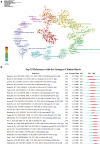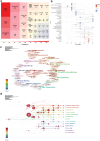A bibliometric analysis of challenges and advancements in the integrated application of nanoparticles and chimeric antigen receptor T cell therapy
- PMID: 40527861
- PMCID: PMC12184142
- DOI: 10.1080/21645515.2025.2518634
A bibliometric analysis of challenges and advancements in the integrated application of nanoparticles and chimeric antigen receptor T cell therapy
Abstract
In recent years, the integration of nanoparticles with chimeric antigen receptor T-cell (CAR-T) therapy has advanced rapidly, garnering considerable attention from both academic and industrial sectors. However, a comprehensive analysis of key trends and emerging frontiers in this interdisciplinary field remains lacking. To address this gap, we conducted a bibliometric analysis of 515 publications indexed in the Web of Science Core Collection from 2013 to 2024. Using VOSviewer, CiteSpace, and R-bibliometrix, we analyzed publication trends, influential journals, national and institutional contributions, leading authors, and high-impact references. Keyword co-occurrence analyses were performed in VOSviewer, applying a minimum occurrence threshold of five. Citation bursts and clustering analyses of references and keywords were conducted using CiteSpace with default detection settings. Our analysis revealed major research hotspots, especially the optimization of CAR-T cell manufacturing processes and strategies to overcome barriers within the immunosuppressive tumor microenvironment. Looking forward, research is expected to focus increasingly on nanotechnologies such as lipid nanoparticles, precision cell tracking, and siRNA delivery platforms. These innovations hold substantial promise for enhancing the therapeutic efficacy of CAR-T therapies, particularly in the treatment of solid tumors, where conventional approaches remain inadequate. By identifying emerging directions and influential research trends, our analysis highlights the dynamic synergy between nanoparticles and CAR-T therapies, helping to fuel groundbreaking advances in tumor immunotherapy. This study provides data-driven insights that inform clinical trial design, foster interdisciplinary collaboration, and demonstrate the field's strong potential to transform future cancer treatment paradigms.
Keywords: Chimeric antigen receptor T cell therapy; bibliometrics; cell engineering; nanoparticle; tumor immunotherapy; tumor microenvironment.
Conflict of interest statement
No potential conflict of interest was reported by the author(s).
Figures









Similar articles
-
Driving innovations in cancer research through spatial metabolomics: a bibliometric review of trends and hotspot.Front Immunol. 2025 Jun 10;16:1589943. doi: 10.3389/fimmu.2025.1589943. eCollection 2025. Front Immunol. 2025. PMID: 40557160 Free PMC article.
-
Bibliometric and visualized analysis of global distribution and research frontiers in tumor immune escape.Front Immunol. 2025 Jun 5;16:1586120. doi: 10.3389/fimmu.2025.1586120. eCollection 2025. Front Immunol. 2025. PMID: 40539064 Free PMC article.
-
Data-driven trends in critical care informatics: a bibliometric analysis of global collaborations using the MIMIC database (2004-2024).Comput Biol Med. 2025 Sep;195:110670. doi: 10.1016/j.compbiomed.2025.110670. Epub 2025 Jun 27. Comput Biol Med. 2025. PMID: 40580617
-
A bibliometric analysis of research trends in mesenchymal stem cell therapy for neonatal bronchopulmonary dysplasia: 2004-2024.Front Pediatr. 2025 Jun 3;13:1558301. doi: 10.3389/fped.2025.1558301. eCollection 2025. Front Pediatr. 2025. PMID: 40530182 Free PMC article. Review.
-
Current status, hotspots, and trends in cancer prevention, screening, diagnosis, treatment, and rehabilitation: A bibliometric analysis.Oncol Res. 2025 May 29;33(6):1437-1458. doi: 10.32604/or.2025.059290. eCollection 2025. Oncol Res. 2025. PMID: 40486880 Free PMC article.
References
-
- Berdeja JG, Madduri D, Usmani SZ, Jakubowiak A, Agha M, Cohen AD, Stewart AK, Hari P, Htut M, Lesokhin A, et al. Ciltacabtagene autoleucel, a B-cell maturation antigen-directed chimeric antigen receptor T-cell therapy in patients with relapsed or refractory multiple myeloma (CARTITUDE-1): a phase 1b/2 open-label study. Lancet. 2021. Jul 24;398(10297):314–324. doi: 10.1016/S0140-6736(21)00933-8. - DOI - PubMed
MeSH terms
Substances
LinkOut - more resources
Full Text Sources
Medical
Miscellaneous
